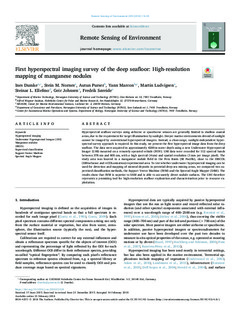| dc.contributor.author | Dumke, Ines | |
| dc.contributor.author | Nornes, Stein Melvær | |
| dc.contributor.author | Purser, Autun | |
| dc.contributor.author | Marcon, Yann | |
| dc.contributor.author | Ludvigsen, Martin | |
| dc.contributor.author | Ellefmo, Steinar Løve | |
| dc.contributor.author | Johnsen, Geir | |
| dc.contributor.author | Søreide, Fredrik | |
| dc.date.accessioned | 2018-09-05T07:14:06Z | |
| dc.date.available | 2018-09-05T07:14:06Z | |
| dc.date.created | 2018-02-23T10:14:44Z | |
| dc.date.issued | 2018 | |
| dc.identifier.citation | Remote Sensing of Environment. 2018, 209 19-30. | nb_NO |
| dc.identifier.issn | 0034-4257 | |
| dc.identifier.uri | http://hdl.handle.net/11250/2560814 | |
| dc.description.abstract | Hyperspectral seafloor surveys using airborne or spaceborne sensors are generally limited to shallow coastal areas, due to the requirement for target illumination by sunlight. Deeper marine environments devoid of sunlight cannot be imaged by conventional hyperspectral imagers. Instead, a close-range, sunlight-independent hyperspectral survey approach is required. In this study, we present the first hyperspectral image data from the deep seafloor. The data were acquired in approximately 4200 m water depth using a new Underwater Hyperspectral Imager (UHI) mounted on a remotely operated vehicle (ROV). UHI data were recorded for 112 spectral bands between 378 nm and 805 nm, with a high spectral (4 nm) and spatial resolution (1 mm per image pixel). The study area was located in a manganese nodule field in the Peru Basin (SE Pacific), close to the DISCOL (DISturbance and reCOLonization) experimental area. To test whether underwater hyperspectral imaging can be used for detection and mapping of mineral deposits in potential deep-sea mining areas, we compared two supervised classification methods, the Support Vector Machine (SVM) and the Spectral Angle Mapper (SAM). The results show that SVM is superior to SAM and is able to accurately detect nodule surfaces. The UHI therefore represents a promising tool for high-resolution seafloor exploration and characterisation prior to resource exploitation. | nb_NO |
| dc.language.iso | eng | nb_NO |
| dc.publisher | Elsevier | nb_NO |
| dc.relation.uri | https://doi.pangaea.de/10.1594/PANGAEA.874408 | |
| dc.rights | Attribution-NonCommercial-NoDerivatives 4.0 Internasjonal | * |
| dc.rights.uri | http://creativecommons.org/licenses/by-nc-nd/4.0/deed.no | * |
| dc.title | First hyperspectral imaging survey of the deep seafloor: High-resolution mapping of manganese nodules | nb_NO |
| dc.type | Journal article | nb_NO |
| dc.type | Peer reviewed | nb_NO |
| dc.description.version | publishedVersion | nb_NO |
| dc.subject.nsi | VDP::Marinbiologi: 497 | nb_NO |
| dc.subject.nsi | VDP::Marine biology: 497 | nb_NO |
| dc.source.pagenumber | 19-30 | nb_NO |
| dc.source.volume | 209 | nb_NO |
| dc.source.journal | Remote Sensing of Environment | nb_NO |
| dc.identifier.doi | 10.1016/j.rse.2018.02.024 | |
| dc.identifier.cristin | 1568121 | |
| dc.relation.project | Norges forskningsråd: 223254 | nb_NO |
| dc.relation.project | Norges forskningsråd: 250228 | nb_NO |
| dc.relation.project | EC/FP7/604500 | nb_NO |
| dc.description.localcode | © 2018 The Authors. Published by Elsevier Inc. This is an open access article under the CC BY-NC-ND license (http://creativecommons.org/licenses/BY-NC-ND/4.0/). | nb_NO |
| cristin.unitcode | 194,64,20,0 | |
| cristin.unitcode | 194,64,90,0 | |
| cristin.unitcode | 194,66,10,0 | |
| cristin.unitname | Institutt for marin teknikk | |
| cristin.unitname | Institutt for geovitenskap og petroleum | |
| cristin.unitname | Institutt for biologi | |
| cristin.ispublished | true | |
| cristin.fulltext | original | |
| cristin.qualitycode | 2 | |

